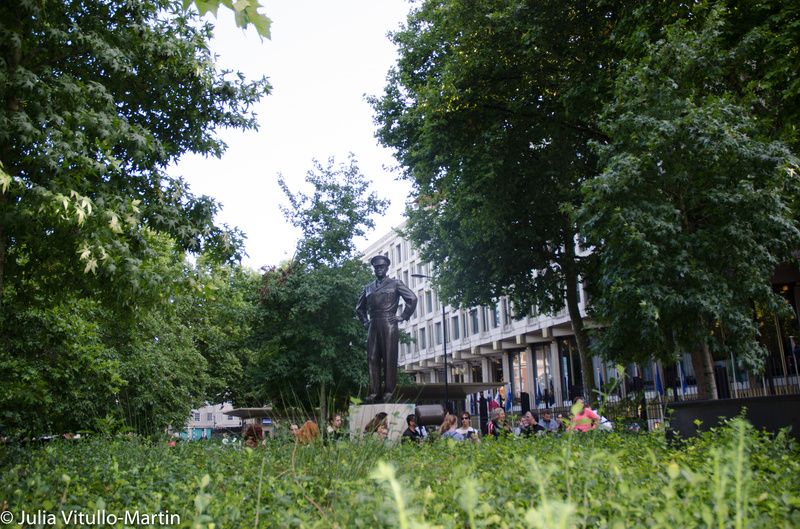Last Chance to Catch NYC's Holiday Notalgia Train
We met the voices of the NYC subway on our nostalgia ride this weekend!


For some time now, we’ve been religiously following the progress of the TWA Hotel inside John F. Kennedy Airport’s iconic TWA Flight Center, a midcentury marvel by architect Eero Saarinen. In anticipation of its opening, we’re taking a look back at Saarinen’s distinctively modernist U.S. embassy (officially the U.S. Chancery) in London, which opened in 1960 at a high point in US-Anglo relations. Since 1938, it has stood in Grosvenor Square, which was the site of General Dwight D Eisenhower’s headquarters in World War II, and often called “Little America” (a title that will now be conferred south of the Thames, says US Ambassador Robert Johnson). The U.S. embassy journeyed from promising symbol of a cooperative future in the Kennedy-Macmillan era to an often unloved, heavily armed citadel of iron and concrete barriers after 9/11.
In 2004, The New York Times derided the security measures that resulted in the embassy’s “hulking menacingly in genteel Mayfair.” Yet, in its early hopeful days, the embassy ran a renowned library open to the public. Its elegant furniture and fixtures were designed by Charles and Ray Eames, its terrazzo floors gleamed, and light poured in from its cleverly designed exterior.
When Donald Trump tweeted his condemnation of the relocation of the American embassy, he was both right and wrong: “Reason I canceled my trip to London is that I am not a big fan of the Obama Administration having sold perhaps the best located and finest embassy in London for ‘peanuts,’ only to build a new one in an off location for 1.2 billion dollars. Bad deal. Wanted me to cut ribbon-NO!”
Trump was right that it may well have been America’s finest embassy ever, and that its posh Grosvenor Square location may have been the best of any American embassy anywhere. He was wrong, though, that the Obama administration made the decision to leave central London for its outskirts. That was the Bush Administration (although the ground-breaking for the new embassy did not occur until November 2013). Or as The Economist’s Prospero summarized, “The State Department is in the process of moving the American embassy in London from glamorous Mayfair to a 450-acre industrial site on the south bank of the River Thames.” The new owners of the Saarinen building are Qatari Diar, the development wing of the Qatari government, which will convert Saarinen’s masterpiece into a hotel.
The distinguished architectural critic Paul Goldberger commented: “In those post-war days, we were trying to do our very best architecture with our embassies, and this was a totally right building that fit beautifully into the urban fabric of that part of London. I’m sure there were discussions with London planners influencing Saarinen because, on his own, he was generally much less contextually responsive than you see in that building. Saarinen was a wonderful architect, but left to his own devices, he was likely to produce something closer to the isolated sculptural splendor of JFK’s TWA building, a building you admire in spite of its lack of urbanistic qualities, not because of them. This is a building you admire for its urbanistic qualities.”
Goldberger calls it “a beautiful fourth wall to Grosvenor Square,” a communal space that even after 9/11 remained welcoming to the public, although its fourth wall barricaded itself against intruders.
The building that is closing in controversy actually opened in controversy as well. In a 1960 New York Times Magazine piece, Richard B Morris, chair of Columbia University’s Department of History, castigated Saarinen’s choice of an eagle as a central, unifying symbol. Morris called the eagle “lazy, cowardly, rapacious, and hardly a fit national emblem.” As if that wasn’t enough, he added that the eagle is a “gangster bird, a hijacker” and a “gilded bird of prey will cast a sinister shadow” of America.

Demonstrations occurred regularly in front of the Eisenhower statue, U.S. Embassy, Grosvenor Square, London
No wimp, Saarinen responded by letter that Morris was just an angry historian,” that the eagle is a noble creature, and that sculptor Theodore Roszak is one of America’s foremost artists. The eagle, in a light gold color, is made of hand-wrought anodized aluminum, with a 36-foot wingspread. Saarinen also noted that the embassy is constructed of Portland stone, traditional to London’s office buildings, and that it “has been used so it will weather to the dramatic black-and-white contrasts characteristic of London.”
No one knows the actual sales price to the Quataris, but because the British preservation society, Historic England, gave the building a Grade II classification, permanently preserving the facade, its value probably decreased to £500 million or less — part of @realDonaldTrump’s grievance. But, says Goldberger, “of all the things that could have happened to the building, a hotel is not so bad, and may end up being more open to the public than the embassy had been in its last few years.”
It’s likely that the embassy’s former neighbors, including the likes of Princess Diana’s step-mother, will be happy to see it go because security had become so intrusive. Nonetheless Hugh Pearman, architecture critic of the Sunday Times, London, wrote in the Wall Street Journal, “Love it or loathe it, this building has enormous character, the expression of a subtle architectural intelligence. I know this: If we lose it, we will come to regret it.” While London is not losing the building itself, the progressive future it embodied to the Kennedy administration is now little more than a memory.
Julia Vitullo-Martin is a senior fellow at the Regional Plan Association. Get in touch with her @JuliaManhattan.
Subscribe to our newsletter